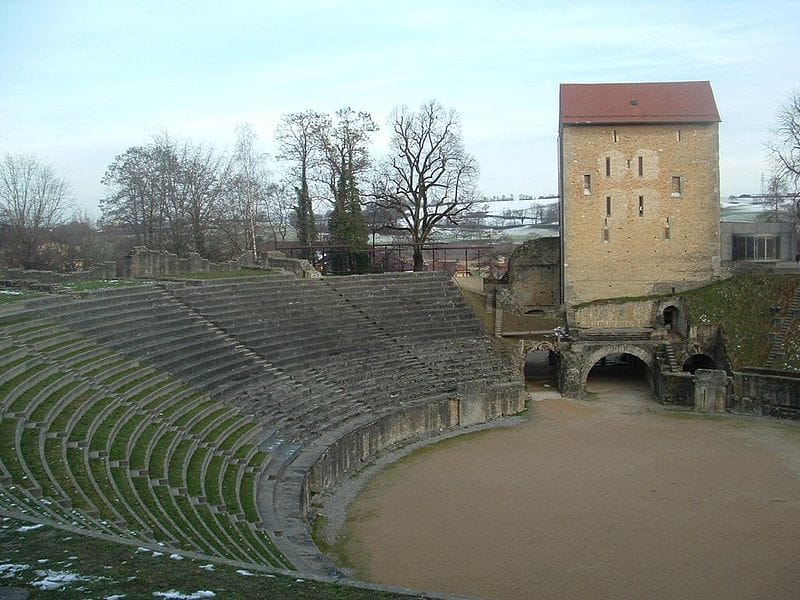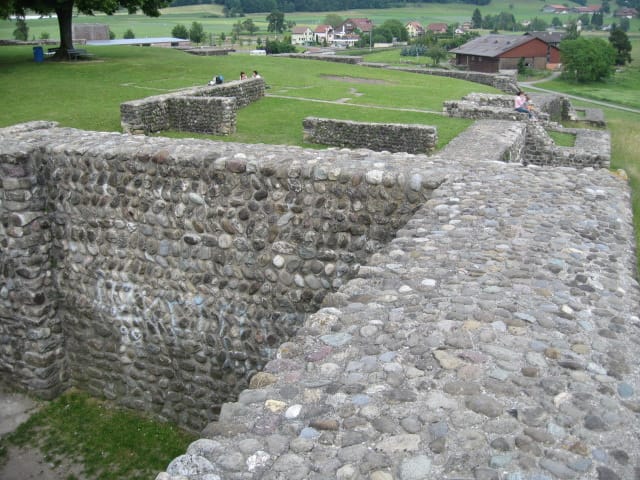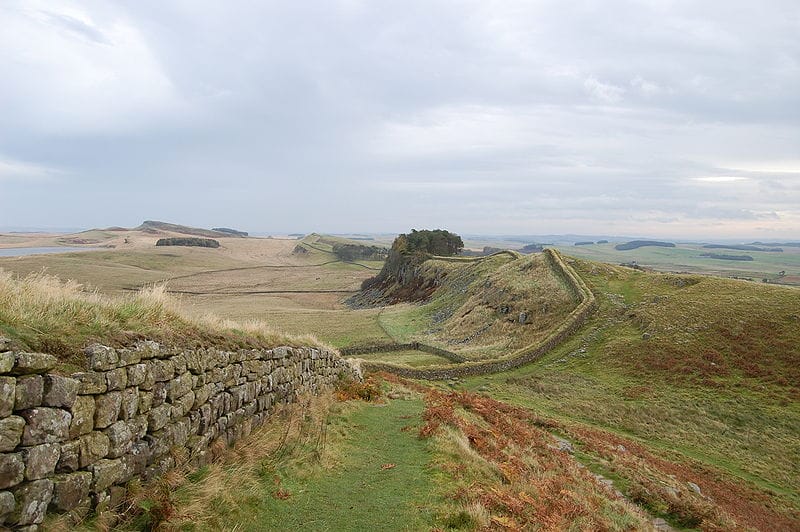Archaeologists in Switzerland have discovered an ancient Roman wall, which they believe is a significant find. The wall, which is believed to date back to the 3rd century AD, was discovered in the city of Windisch, in the northern part of the country. The discovery has been described as an “archaeological sensation” by experts in the field.
The Roman wall is believed to have been part of a larger Roman settlement in the area, which was known as Vindonissa. The settlement was an important military base for the Roman army and was located on the banks of the River Aare. The discovery of the wall is expected to shed new light on the history of the settlement and the role it played in the Roman Empire.
According to the archaeologists involved in the project, the wall is approximately 100 meters long and 3 meters high. It is made of stone and is believed to have been part of a larger defensive structure. The discovery of the wall is seen as a significant breakthrough in the study of the Roman Empire.
Discovery of the Ancient Roman Wall
Archaeologists in Switzerland have made an incredible discovery that could change the way we understand the history of the region. A team of researchers from the University of Basel has uncovered the remains of an ancient Roman wall that was previously unknown to historians. The wall was discovered in the town of Windisch, near the border with Germany, and is believed to date back to the 3rd century AD. It is thought to have been part of a larger defensive structure that was built to protect the Roman province of Germania Superior.
The discovery was made during a routine excavation of a construction site, and the team was stunned by what they found. The Roman wall is made of stone and is over two meters tall in some places. It stretches for over 100 meters and is believed to have been part of a larger fortification that has yet to be fully explored. The Roman Empire had a profound impact on the history of Europe, and this wall is a tangible reminder of the power and influence of the ancient civilization. It also sheds new light on the history of Switzerland, which was not previously thought to have been a significant part of the Roman Empire.
Further excavations are planned at the site, and archaeologists are hopeful that they will uncover more artifacts and information about the wall and the people who built it. This discovery is a testament to the power of archaeology to uncover new information about our past, and it is sure to be studied and analyzed for years to come.
Historical Significance of the Find
The wall, which is believed to date back to the 3rd century AD, was uncovered during construction work in the town of Windisch. It is thought to be part of a larger Roman fortification system that was built along the Rhine River to protect the Roman Empire from invading Germanic tribes. The fortifications were an important part of the Roman military strategy, and their construction helped to consolidate Roman power in the region.
This discovery is significant because it provides evidence of the extent of Roman influence in Switzerland during the 3rd century AD. The Roman Empire had a significant impact on the region, introducing new technologies, trade, and cultural practices that shaped the development of Switzerland and the wider European continent.
Archaeological Methods Used in the Excavation
The discovery of the ancient Roman wall in Switzerland was a result of careful archaeological excavation. The team of archaeologists used a variety of methods to uncover the wall and learn more about its history. One of the primary methods used was ground-penetrating radar (GPR). This technology uses radar pulses to create images of the subsurface. By analyzing the images, the archaeologists were able to identify the presence of the wall and map out its dimensions.
The team also used excavation techniques to uncover the wall. They carefully removed layers of soil and debris to expose the wall and study its construction. This process was slow and meticulous, as the archaeologists had to be careful not to damage the wall during the excavation. Once the wall was uncovered, the team used a variety of tools to study it in more detail. They took measurements of the Roman wall’s height, thickness, and length, and analyzed the materials used in its construction. This information helped them to better understand the wall’s purpose and how it was built.
The excavation of the ancient Roman wall in Switzerland was a complex and multi-faceted process. By using a combination of technologies and techniques, the archaeologists were able to uncover an important piece of history and learn more about the ancient Roman presence in the region.

Location and Description of the Wall
Archaeologists have made an extraordinary discovery in Switzerland, unearthing an ancient Roman wall that dates back to the 3rd century AD. The wall is located in the canton of Aargau and is believed to be part of a larger fortification system built by the Romans to defend their empire against invading Germanic tribes. The wall measures approximately 100 meters in length and is made of limestone blocks that are up to 1 meter thick. It stands at a height of around 2 meters and is in remarkably good condition, considering its age.
The wall is believed to have been built by the Legio XIII Gemina, a Roman legion that was stationed in the area during the 3rd century AD. The wall is part of a larger archaeological site that includes the remains of a Roman military camp and a civilian settlement. The site was first discovered in the 19th century but was largely forgotten until recent excavations brought it back to light.
Roman Architecture and Construction Techniques
The Ancient Roman Wall discovered in Switzerland is a great example of the remarkable architecture and construction techniques of the Roman Empire. Romans were renowned for their engineering skills and their ability to build structures that stood the test of time. The wall in Switzerland is no exception.
Roman architects used a combination of materials to construct their buildings and walls. The most common materials used were stone, brick, and concrete. They also used wood for scaffolding and temporary structures. The use of concrete was particularly innovative, as it allowed the Romans to build structures quickly and efficiently. One of the most impressive features of Roman architecture was the Romans’s use of arches and vaults. Arches were used to span openings such as doorways and windows, while vaults were used to create ceilings and roofs. This technique allowed the Romans to build large, open spaces without the need for supporting columns.
Another important aspect of Roman architecture was the use of decorative elements. They used intricate carvings and sculptures to adorn their buildings and walls. This not only added to the aesthetic appeal of the structures but also served as a way to convey important messages and symbols. The discovery of this Wall in Switzerland is a significant archaeological find that sheds light on the impressive construction techniques of the Roman Empire. The use of durable materials, arches, vaults, and decorative elements all contributed to the longevity and beauty of their structures.
Impact on Understanding of Roman Presence in Switzerland
The discovery of the wall confirms that the Romans had a significant presence in Switzerland during the 3rd century AD. This is important because there has been little evidence of Roman activity in this region during this period. The wall suggests that the Romans were not only present in Switzerland but also had a military presence in the area.

The wall also provides insight into the Roman military strategy in Switzerland. The wall is believed to have been part of a larger defensive system that protected the Roman Empire from the Germanic tribes to the north. The discovery of the wall shows that the Romans were actively engaged in defending their territory in Switzerland.
This discovery highlights the importance of archaeology in uncovering the hidden history of Switzerland. The wall was discovered during an excavation for a new building, demonstrating the importance of conducting archaeological surveys before construction projects begin. The discovery of the wall shows that there may be many more hidden treasures waiting to be uncovered in Switzerland.
Preservation and Conservation Efforts
This finding has sparked a lot of interest among archaeologists and history enthusiasts alike. However, the preservation and conservation of this valuable artifact are of utmost importance to ensure its longevity and protect it from damage or decay. To preserve the wall, experts have employed various techniques such as cleaning, stabilizing, and reinforcing the structure. They have also installed protective measures to prevent further erosion and damage caused by weather conditions and human interference.
Conservation efforts involve not only preserving the physical structure of the wall but also documenting and studying it for historical and archaeological purposes. Experts have conducted extensive research to understand the wall’s construction, purpose, and significance in Roman history. To ensure the wall’s long-term preservation, experts have established a monitoring system to regularly check for any signs of deterioration or damage. They have also implemented strict guidelines for visitors to prevent any accidental damage or vandalism.
Public and Academic Response
The finding was first announced by a team of archaeologists from the University of Zurich, who have been conducting excavations in the area for several years. Since the news broke, there has been a flurry of media coverage, with many outlets reporting on the significance of the discovery. Some have described it as a “sensation,” while others have praised the team for their hard work and dedication.
The academic community has also been quick to respond, with many experts expressing their excitement at the find. Some have suggested that the wall could be part of a larger Roman settlement in the region, while others have speculated that it may have been built as a defensive structure. Despite the excitement, however, many experts have cautioned against jumping to conclusions. They have stressed the need for further research and analysis, in order to fully understand the significance of the find.
The response to the discovery has been overwhelmingly positive, with many people expressing their fascination with the history of the region. As more information becomes available, it is likely that interest in the discovery will only continue to grow.
Future Research and Excavation Prospects
The discovery of the ancient Roman wall in Switzerland has opened up a new avenue of research for archaeologists and historians. The wall is expected to provide crucial insights into the military and political strategies of the Roman Empire. Excavation of the site is expected to continue for several years, with teams of archaeologists and researchers working to uncover more artifacts and structures. The excavation process will involve careful documentation and analysis of the findings, as well as preservation of the site for future generations.
One area of particular interest is the possible connection between the Roman wall in Switzerland and other fortifications along the Roman frontier. Researchers will be looking for similarities in construction techniques, materials used, and strategic placement of the walls.

Another area of focus will be the cultural and social impact of the Roman presence in Switzerland. Archaeologists will be looking for evidence of Roman settlements, trade, and interaction with local populations.
Overall, the discovery of this wall has opened up a wealth of research opportunities for archaeologists and historians. With careful excavation and analysis, researchers hope to gain a better understanding of the Roman Empire’s military and political strategies, as well as its cultural and social impact on the regions it occupied.
People Also Ask:
What is the significance of the recently discovered Roman wall in Switzerland?
The discovery of a Roman wall in Switzerland is significant because it sheds light on the extent of Roman expansion in the region. This finding suggests that the Romans had a presence in Switzerland beyond what was previously believed.
How does the discovery of Roman ruins in Switzerland contribute to our understanding of ancient Roman architecture?
It contributes to our understanding of ancient Roman architecture by providing a glimpse into the building techniques and materials used during that time period. It also helps us understand how the Romans adapted their architecture to different regions and climates.
What are the implications of recent Roman archaeological findings on the history of Roman expansion?
Recent Roman archaeological findings have important implications for our understanding of Roman expansion. They suggest that the Romans had a much wider reach than previously thought, and that their influence extended far beyond their borders.
Can the discovery of Roman ruins in Switzerland offer insights into ancient Roman urban planning?
By studying the layout of the ruins, archaeologists can gain a better understanding of how the Romans planned and organized their cities.
What types of artifacts have been uncovered alongside the Roman wall in Switzerland?
Alongside the Roman wall in Switzerland, archaeologists have uncovered a variety of artifacts including coins, pottery, and tools. These artifacts provide valuable insights into the daily lives of the people who lived in the area during Roman times.
How will the Roman wall discovery in Switzerland affect future archaeological research in the region?
The discovery will undoubtedly lead to further archaeological research in the region. This finding will likely inspire more excavations and studies in the area, which will contribute to our understanding of ancient Roman history and culture.
Hello, my name is Vladimir, and I am a part of the Roman-empire writing team.
I am a historian, and history is an integral part of my life.
To be honest, while I was in school, I didn’t like history so how did I end up studying it? Well, for that, I have to thank history-based strategy PC games. Thank you so much, Europa Universalis IV, and thank you, Medieval Total War.
Since games made me fall in love with history, I completed bachelor studies at Filozofski Fakultet Niš, a part of the University of Niš. My bachelor’s thesis was about Julis Caesar. Soon, I completed my master’s studies at the same university.
For years now, I have been working as a teacher in a local elementary school, but my passion for writing isn’t fulfilled, so I decided to pursue that ambition online. There were a few gigs, but most of them were not history-related.
Then I stumbled upon roman-empire.com, and now I am a part of something bigger. No, I am not a part of the ancient Roman Empire but of a creative writing team where I have the freedom to write about whatever I want. Yes, even about Star Wars. Stay tuned for that.
Anyway, I am better at writing about Rome than writing about me. But if you would like to contact me for any reason, you can do it at [email protected]. Except for negative reviews, of course. 😀
Kind regards,
Vladimir
